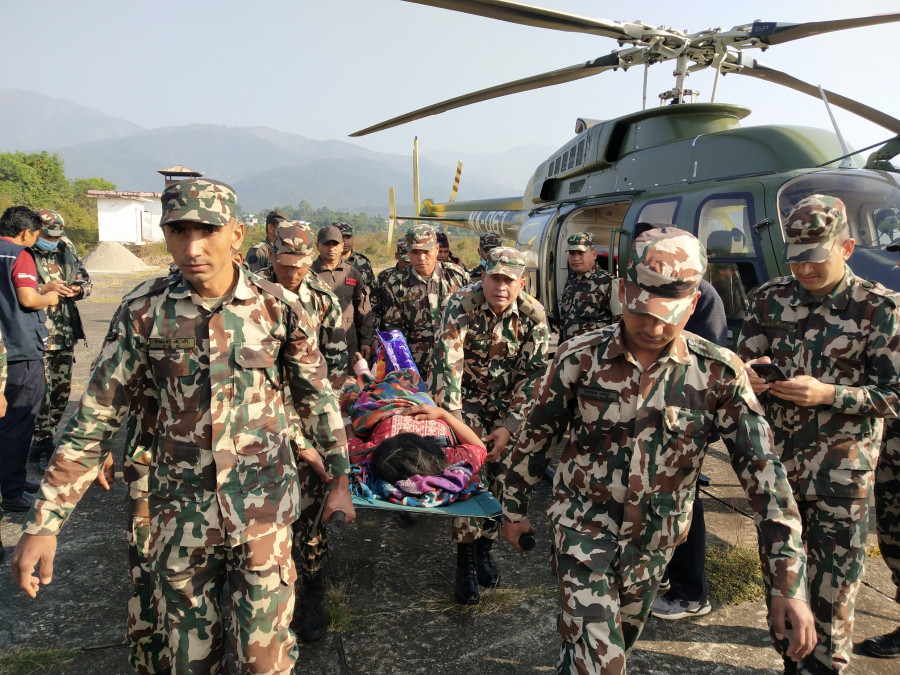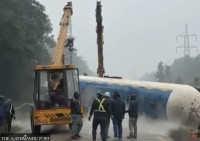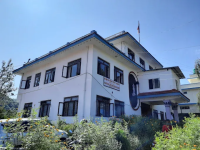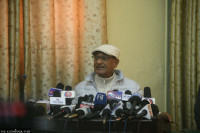National
Thousands of security personnel mobilised in search and rescue efforts
They have also medevaced the seriously injured to the urban centres.
Post Report
State security agencies, in coordination with local government and humanitarian organisations, have mobilised teams for search and rescue operations following the Jajarkot earthquake.
Squads of Nepal Army, Armed Police Force and Nepal Police stationed in the earthquake-affected districts were mobilised in search efforts immediately after the magnitude 6.4 quake struck the Karnali Province close to midnight on Friday. Additional forces were mobilised from Saturday morning.
Close to 4,000 personnel from the Nepal Army, the Armed Police Force and the Nepal Police have been deployed in parts of Jajarkot and Rukum West districts for rescue operations. Dozens of volunteers from the Nepal Red Cross Society and other organisations were also mobilised soon after the disaster.
According to Nepal Army spokesperson Brigadier General Krishna Bhandari, personnel from three battalions, including medical and aviation teams, have been sent to the two districts hit hardest by the earthquake. A battalion has anywhere between 800 and 1,000 personnel. Many of the soldiers mobilised are trained to search collapsed structures for people and to provide quick responses.
Armed Police has deployed around 500 personnel including the medics. Close to a fourth of its personnel are fully trained in disaster response. Nepal Police, working hand in hand with the other two security agencies, has 859 personnel responding to the disaster in the two districts.
“We primarily focused on search and rescue operations on day one. As the first 72 hours are considered the golden period [for successful rescue], we will prioritise search and rescue for a few more days,” Bhandari told the Post. “However, relief distribution too will go hand in hand from now onward.”
The army is using five aircraft including a Sky Truck to ferry rescue and medical teams to affected areas while also airlifting the injured and deceased.
Apart from rescuing the victims, security forces have taken seriously injured persons to health facilities in Kathmandu, Nepalgunj and Surkhet. While the national defence force ferried 31 severely injured to Nepalgunj and Surkhet for treatment after first aid, Nepal Police brought eight seriously injured to Kathmandu. They are being treated at the Tribhuvan University Teaching Hospital.
Deputy Inspector General Kuber Kadayat, also the Nepal Police spokesperson, said hundreds of people have been affected by the disaster. However, as they were more focused on search and rescue, details of the affected are yet to be ascertained.
“We will start collecting data on the affected and the number of the houses damaged or destroyed once the search and rescue phase is over,” he told the Post. Because the earthquake destroyed bridges and triggered landslides in places, rescue teams found it difficult to reach the affected areas.
“There are a few places, mainly in northern Jajarkot, where our teams are yet to reach. They will be there as soon as possible,” said Bhandari. As per the security forces, save for some effort on the part of some non-government agencies, there was no major relief distribution effort on Saturday.
The government on Saturday evening decided to send relief materials like blankets, clothing and food items starting Sunday. The distribution of relief materials donated by the different agencies will also be carried out.
Local government officials say the situation was chaotic in the morning due to inadequate means to deal with the disaster.
Harischandra Sharma, assistant chief district officer in Jajarkot, said the under-resourced and poorly equipped district hospital was struggling.
“The hospital lacks both human resources and equipment to deal with a huge number of victims. We were struggling to cope with things on Saturday morning,” he told the Post. “The situation has largely come under control with more doctors and medical teams arriving from Kathmandu and Surkhet.”
Apart from the medical squads of the three security agencies, doctors from Surkhet and adjoining districts too reached the affected districts.
“The people have been compelled to live in the cold under the open sky after they lost their houses to the disaster. Supporting them with relief materials should be our major focus. We are working to this effect,” he told the Post.




 13.12°C Kathmandu
13.12°C Kathmandu












%20(1).jpg&w=300&height=200)

